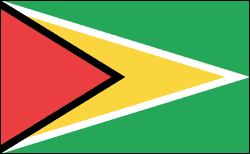Guyana History


History
The first known inhabitants of Guyana were groups of distinct settlers known as the Warao (Warrau), Carib, and Arawak. These are believed to have migrated from Eurasia around 40,000 years ago.
The first documented contacts take place as Dutch, English, and French forces established colonies in what is now known as Guyana. During the early 17th century the majority of these settlements were Dutch.
During the Napoleonic wars, Britain took over the Dutch colonies of Berbice, Demerara, and Essequibo, which became British Guiana in 1831. Slavery was outlawed in 1834, and the great need for plantation workers led to a large wave of immigration, primarily of East Indians.
Today, about half of the population is of East Indian descent and about 36% are of African descent.
Population growth in Guyana was accelerated by the discovery of gold in the 1890s. The timber-rich Essequibo territory to the west of Guyana also attracts increasing interest and triggers a territorial dispute with Venezuela.
In 1889, Venezuela voiced its claim to the territory but ten years later an international tribunal ruled the land belonged to British Guiana. The 1899 award is still being contested in the international law courts by the two nations.
Guyana Gains Independence
British Guiana became a Crown colony in 1928, and in 1953 it was granted home rule. In 1950, Cheddi Jagan, who was Indian-Guyanese, and Forbes Burnham, who was Afro-Guyanese, created the colony's first political party, the Progressive People's Party (PPP), which was dedicated to gaining the colony's independence.
In the 1953 elections, Cheddi Jagan was elected chief minister. The British, however, alarmed by Jagan's Marxist views, suspended the constitution and government within months and installed an interim government. In 1955, the PPP split, with Burnham breaking off to create the People's National Congress (PNC).
The leftist Jagan of the PPP and the more moderate Burnham of the PNC were to dominate Guyanan politics for decades to come. In 1961, Britain granted the colony autonomy, and Jagan became prime minister (1961–1964). Strikes and rioting weakened Jagan's rule, much of it believed to be the result of covert CIA operations. In 1964, Burnham succeeded Jagan as prime minister, a position he retained after the country gained full independence on May 26, 1966. With independence, the country returned to its traditional name, Guyana.
Jonestown Mass Suicide
In 1978, the country gained worldwide attention when American religious cult leader Jim Jones and 900 of his followers committed mass suicide in Jonestown, Guyana. The cult relocated to Guyana in 1974 after having attracted support in the U.S. cities of San Francisco and Los Angeles.
First Constitution
The establishment of a constitution in 1980 identifies the President as the Head of State and the Supreme Executive Authority. It replaced the British Monarchy with a ceremonial president.
Forbes Burnham became the first Executive President when he was elected as a representative of the People's National Congress Reform party. He rules Guyana until his death in 1985. Guyana's first independent decades were marked by continued racial unrest between Indian-Guyanese and Afro-Guyanese as well as economic malaise.
Desmond Hoyte of the PNC became president in 1985, but in 1992 the PPP reemerged, winning a majority in the general election. Jagan became president, and the former Marxist succeeded in reviving the economy. After his death in 1997, his wife, Janet Jagan, was elected president. Former finance minister Bharrat Jagdeo assumed the presidency in 1999.







